ESP DODGE SPRINTER 2005 1.G Owners Manual
[x] Cancel search | Manufacturer: DODGE, Model Year: 2005, Model line: SPRINTER, Model: DODGE SPRINTER 2005 1.GPages: 288, PDF Size: 27.89 MB
Page 9 of 288

INTRODUCTION 9
1
INFORMATION REGARDING ELECTRONIC
RECORDING DEVICES(Including notice pursuant to California Code § 9951)
Please note that your vehicle is equipped with devices
that can record vehicle systems data.
This information helps, for example, to diagnose
vehicle systems after a collision and to continuously
improve vehicle safety. DaimlerChrysler may access
the information and share it with others
for safety research or vehicle diagnosis purposes
with the consent of the vehicle owner or lessee
in response to an official request by law enforcement or other government agency
for use in dispute resolution involving DaimlerChrysler, its affi liates or sales/service
organization and/or
as otherwise required or permitted by law.
STICKERSThere are various warning stickers affixed to the motor
home. Their purpose is to make you and others aware
of various dangers.
WARNING!
Do not remove any warning stickers.
If you remove the warning stickers, you or others
may not be aware of certain dangers and could be
injured.
Page 22 of 288

22 THINGS TO KNOW BEFORE STARTING YOUR VEHICLEPress the Πbutton a second time. The passenger
door and cargo doors are unlocked and the turn signal
lamps, as well as the remote keyless entry transmitter
indicator lamp, blink once again. The button must be
pressed a second time within about 2.5 seconds,
otherwise the second request to open can not be
performed.
NOTE: The vehicle is automatically locked again, if
within about 40 seconds of unlocking with the remote
keyless entry transmitter, none of the doors are
opened. The hazard warning lamp does not blink.Locking with Remote Keyless EntryPress the ‹ button. The entire vehicle is locked and
the hazard warning lamp blinks three times. The
remote keyless entry transmitter indicator lamp blinks
once.
If the hazard warning lamp does not blink, at least one
door is improperly closed. Check to see if there is a
door that is not properly closed or if there is a key in the
ignition lock. Remove key from ignition lock and/or
close doors properly and press the ‹ button again.
REPLACING BATTERIES IN REMOTE KEYLESS
ENTRYDo not touch the battery contact surfaces (insert the
batteries with a lint-free cloth).
NOTE: Do not operate the remote control while the
battery is being replaced.
WARNING!
Keep batteries away from children.
Consult a doctor immediately if a battery is
swallowed.
Dispose of used batteries in an environmentally
responsible manner.
Danger of explosion if the battery is not correctly
replaced. Replacements should always be either
of the same type or one which has been
recommended by the manufacturer.
Page 28 of 288
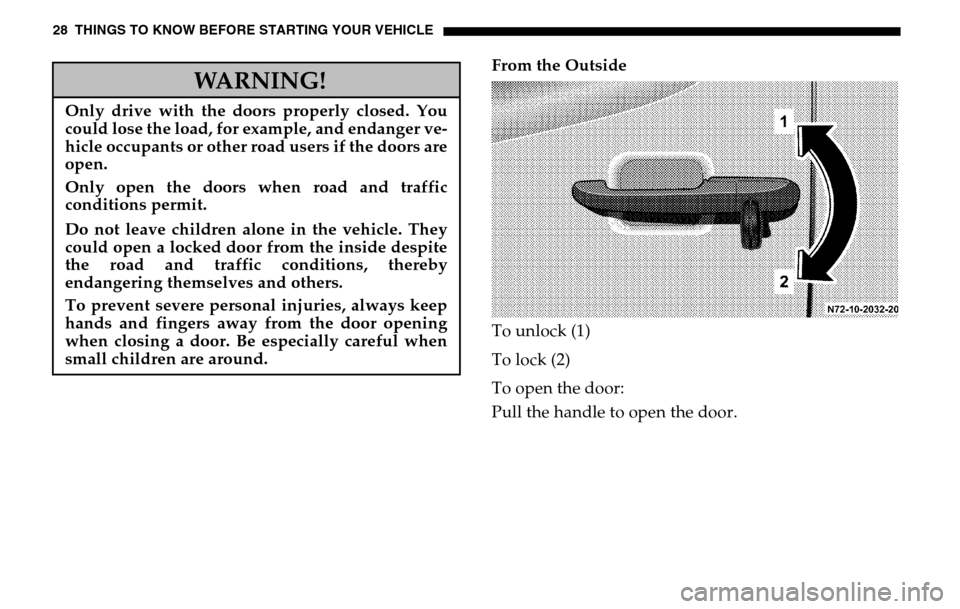
28 THINGS TO KNOW BEFORE STARTING YOUR VEHICLE
From the Outside
To unlock (1)
To lock (2)
To open the door:
Pull the handle to open the door.
WARNING!
Only drive with the doors properly closed. You
could lose the load, for example, and endanger ve-
hicle occupants or other road users if the doors are
open.
Only open the doors when road and traffic
conditions permit.
Do not leave children alone in the vehicle. They
could open a locked door from the inside despite
the road and traffic conditions, thereby
endangering themselves and others.
To prevent severe personal injuries, always keep
hands and fingers away from the door opening
when closing a door. Be especially careful when
small children are around.
Page 29 of 288
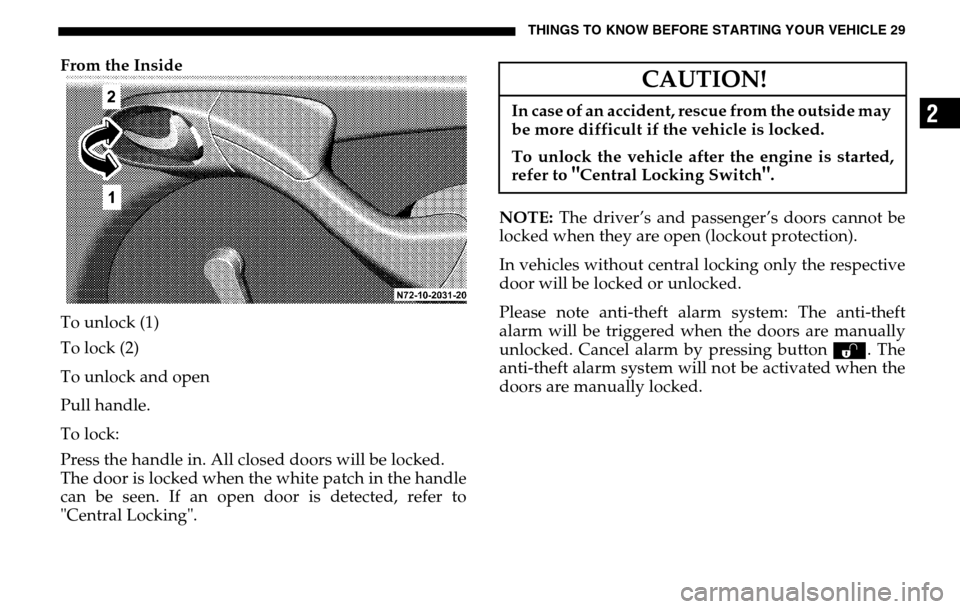
THINGS TO KNOW BEFORE STARTING YOUR VEHICLE 29
2
From the Inside
To unlock (1)
To lock (2)
To unlock and open
Pull handle.
To lock:
Press the handle in. All closed doors will be locked.
The door is locked when the white patch in the handle
can be seen. If an open door is detected, refer to
"Central Locking". NOTE:
The driver’s and passenger’s doors cannot be
locked when they are open (lockout protection).
In vehicles without central locking only the respective
door will be locked or unlocked.
Please note anti-theft alarm system: The anti-theft
alarm will be triggered when the doors are manually
unlocked. Cancel alarm by pressing button Œ. The
anti-theft alarm system will not be activated when the
doors are manually locked.
CAUTION!
In case of an accident, rescue from the outside may
be more difficult if the vehicle is locked.
To unlock the vehicle after the engine is started,
refer to
"Central Locking Switch
".
Page 30 of 288
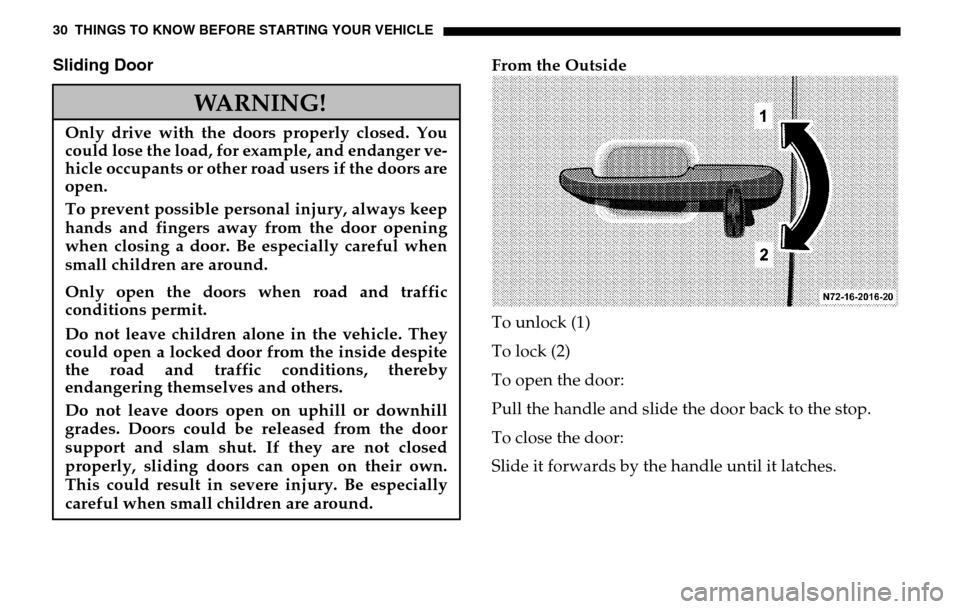
30 THINGS TO KNOW BEFORE STARTING YOUR VEHICLESliding Door
From the Outside
To unlock (1)
To lock (2)
To open the door:
Pull the handle and slide the door back to the stop.
To close the door:
Slide it forwards by the handle until it latches.
WARNING!
Only drive with the doors properly closed. You
could lose the load, for example, and endanger ve-
hicle occupants or other road users if the doors are
open.
To prevent possible personal injury, always keep
hands and fingers away from the door opening
when closing a door. Be especially careful when
small children are around.
Only open the doors when road and traffic
conditions permit.
Do not leave children alone in the vehicle. They
could open a locked door from the inside despite
the road and traffic conditions, thereby
endangering themselves and others.
Do not leave doors open on uphill or downhill
grades. Doors could be released from the door
support and slam shut. If they are not closed
properly, sliding doors can open on their own.
This could result in severe injury. Be especially
careful when small children are around.
Page 32 of 288

32 THINGS TO KNOW BEFORE STARTING YOUR VEHICLEPress lock button (1)
(all doors are locked)
If the central locking automatically unlocks again after
having been locked, at least one door is closed
incorrectly.
If it then locks again within about 5 seconds, then all
closed doors are locked.
The central locking displays vehicle locking with one
or more open doors by means of a special function
sequence (locking, unlocking, locking). Once closing
has been completed, an open door will not
automatically be locked.
NOTE: If an open sliding door is locked before being
closed, then only the sliding door will be locked. In vehicles without central locking only the respective
door will be locked or unlocked.
Please note anti-theft alarm system: The anti-theft
alarm will be triggered when the doors are manually
unlocked. Cancel alarm by pressing button
Œ. The
anti-theft alarm system will not be activated when the
doors are manually locked.
CAUTION!
In case of an accident, rescue from the outside may
be more difficult if the vehicle is locked.
To unlock the vehicle after the engine is started,
refer to
"Central Locking Switch
".
Page 33 of 288
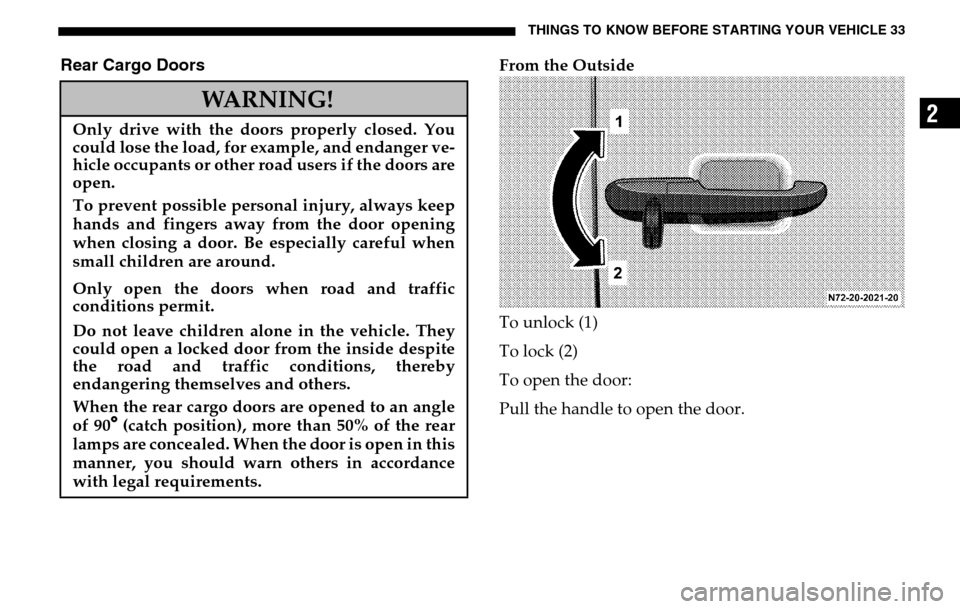
THINGS TO KNOW BEFORE STARTING YOUR VEHICLE 33
2
Rear Cargo Doors
From the Outside
To unlock (1)
To lock (2)
To open the door:
Pull the handle to open the door.
WARNING!
Only drive with the doors properly closed. You
could lose the load, for example, and endanger ve-
hicle occupants or other road users if the doors are
open.
To prevent possible personal injury, always keep
hands and fingers away from the door opening
when closing a door. Be especially careful when
small children are around.
Only open the doors when road and traffic
conditions permit.
Do not leave children alone in the vehicle. They
could open a locked door from the inside despite
the road and traffic conditions, thereby
endangering themselves and others.
When the rear cargo doors are opened to an angle
of 90
°
° °
° (catch position), more than 50% of the rear
lamps are concealed. When the door is open in this
manner, you should warn others in accordance
with legal requirements.
Page 35 of 288
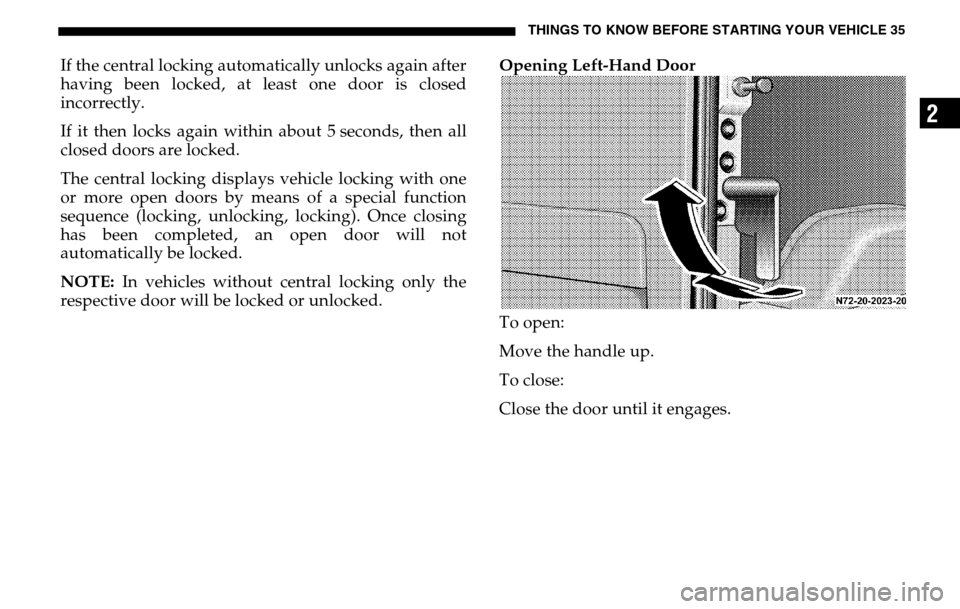
THINGS TO KNOW BEFORE STARTING YOUR VEHICLE 35
2
If the central locking automatically unlocks again after
having been locked, at least one door is closed
incorrectly.
If it then locks again within about 5 seconds, then all
closed doors are locked.
The central locking displays vehicle locking with one
or more open doors by means of a special function
sequence (locking, unlocking, locking). Once closing
has been completed, an open door will not
automatically be locked.
NOTE: In vehicles without central locking only the
respective door will be locked or unlocked. Opening Left-Hand Door
To open:
Move the handle up.
To close:
Close the door until it engages.
Page 37 of 288
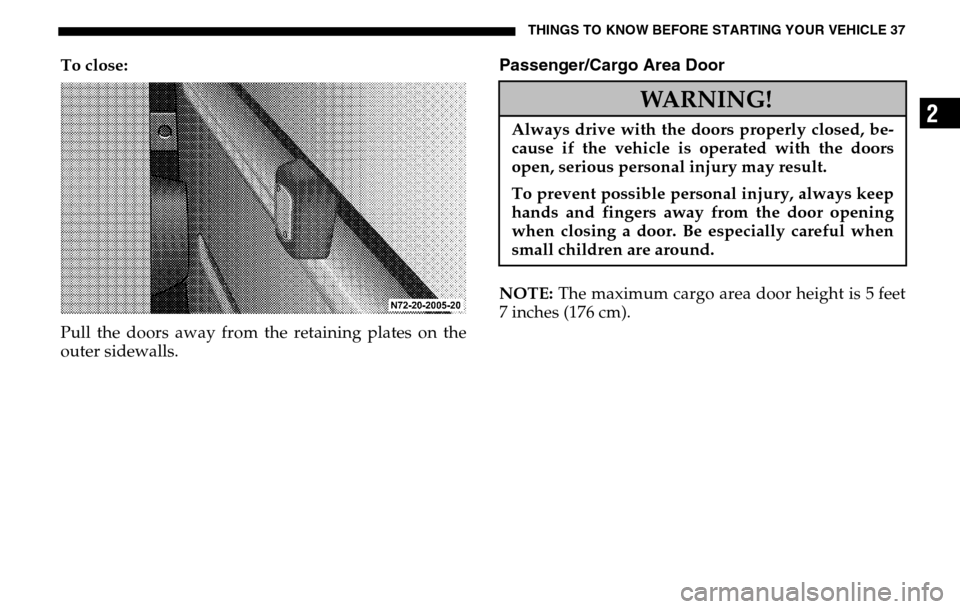
THINGS TO KNOW BEFORE STARTING YOUR VEHICLE 37
2
To close:
Pull the doors away from the retaining plates on the
outer sidewalls.
Passenger/Cargo Area DoorNOTE: The maximum cargo area door height is 5 feet
7 inches (176 cm).
WARNING!
Always drive with the doors properly closed, be-
cause if the vehicle is operated with the doors
open, serious personal injury may result.
To prevent possible personal injury, always keep
hands and fingers away from the door opening
when closing a door. Be especially careful when
small children are around.
Page 50 of 288
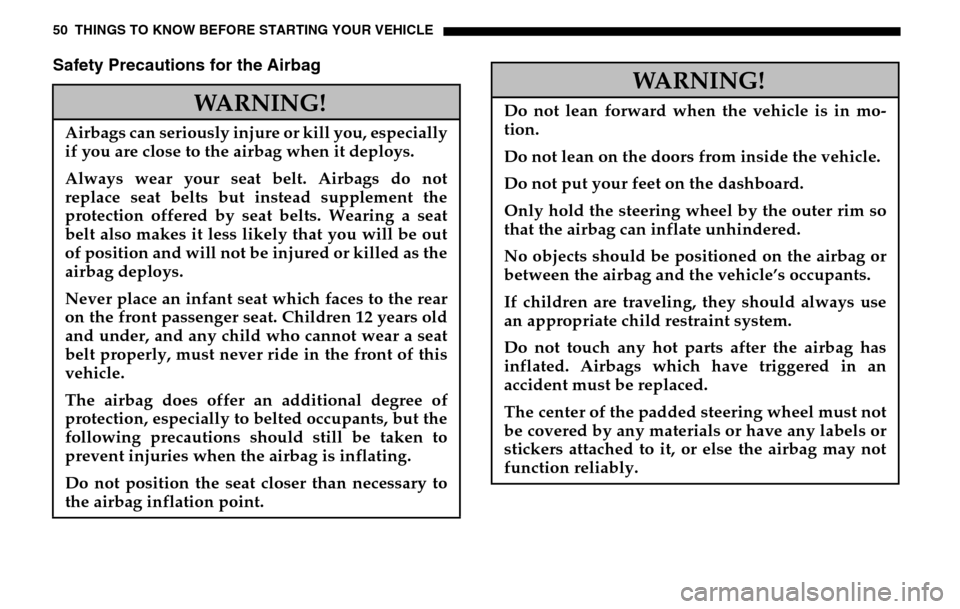
50 THINGS TO KNOW BEFORE STARTING YOUR VEHICLESafety Precautions for the Airbag
WARNING!
Airbags can seriously injure or kill you, especially
if you are close to the airbag when it deploys.
Always wear your seat belt. Airbags do not
replace seat belts but instead supplement the
protection offered by seat belts. Wearing a seat
belt also makes it less likely that you will be out
of position and will not be injured or killed as the
airbag deploys.
Never place an infant seat which faces to the rear
on the front passenger seat. Children 12 years old
and under, and any child who cannot wear a seat
belt properly, must never ride in the front of this
vehicle.
The airbag does offer an additional degree of
protection, especially to belted occupants, but the
following precautions should still be taken to
prevent injuries when the airbag is inflating.
Do not position the seat closer than necessary to
the airbag inflation point.
WARNING!
Do not lean forward when the vehicle is in mo-
tion.
Do not lean on the doors from inside the vehicle.
Do not put your feet on the dashboard.
Only hold the steering wheel by the outer rim so
that the airbag can inflate unhindered.
No objects should be positioned on the airbag or
between the airbag and the vehicle’s occupants.
If children are traveling, they should always use
an appropriate child restraint system.
Do not touch any hot parts after the airbag has
inflated. Airbags which have triggered in an
accident must be replaced.
The center of the padded steering wheel must not
be covered by any materials or have any labels or
stickers attached to it, or else the airbag may not
function reliably.